Springtime — depending on where you are in the world — is usually accompanied by more daylight, warmer weather, and beautiful flowering blossoms. We're excited for the days to come, as well as what you'll do with them! For one, why not take a look at some of our newest Japanese learning resources? We promise you won't want to miss out!
- Lingopie
- Love is Blind: Japan
- StudyIn Daily Japanese
- コツ Pitch Accent Minimal Pairs Test
- 茅ケ崎みなみ
- Onomato Project
- Ulangi App
- ドライブ・マイ・カー / Drive My Car
- Nihongo Alive: Listen & Learn from Real-life Conversations Beginning & Intermediate
- まほろばことば
- 日本語の森 JLPT この一冊で合格する
Lingopie
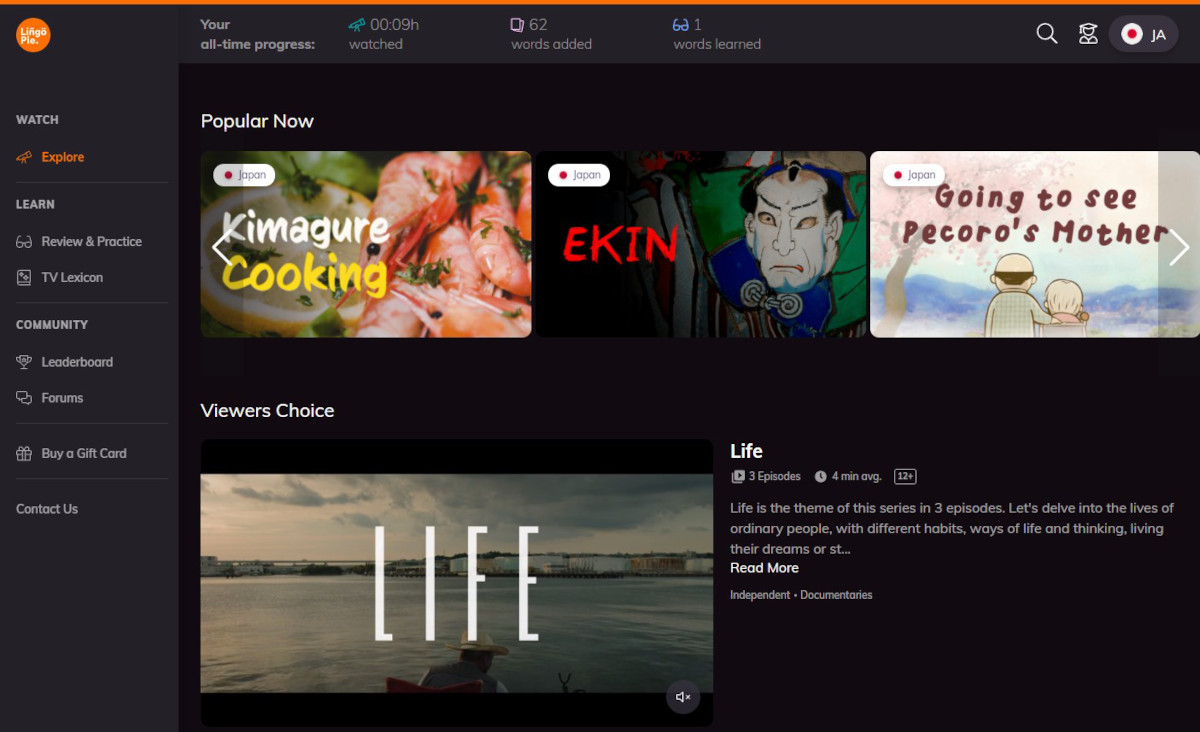
Lingopie is a new language learning app based around language immersion using videos. While there have been a few browser extensions such as Language Reactor (formerly Language Learning with Netflix) with a similar aim, Lingopie offers an all-in-one solution. After signing up under their seven-day free trial, you're asked what language you're learning, and taken to the explore page which should be familiar to users of any popular streaming service.
Videos are sorted by category, and come from networks or independent producers. Clicking on a video takes you to a watch page, though this might be a little different from what you're used to. By default, the transcript is shown on the right of the screen, and subtitles on the video itself. Clicking on a word in either the transcript or subtitle brings up a simple definition in English. There are also buttons on the player to loop a sentence, and slow down playback (though not speed it up). Finally, there are a few buttons dedicated to built-in speaking practice, including a button to play a line in isolation — though strangely it is machine generated rather than the scripted line in the video — and another which allows you to record your own voice and then compare. Flashcards are auto-generated based on "keywords" from the video, though I didn't see any way to generate my own flashcard, or choose which I think are relevant to me. You can do a small pop quiz after watching a video, which tests your understanding of the words used.
It's a neat concept, but as it's in its early days for Japanese, it is lacking in a few areas. For one, the content is a little sparse, and quality varies dramatically. Some videos seem like something you might stumble upon on YouTube, while a few are noticeably better, such as a mini-documentary about an artist. Videos don't seem to have a way to adjust the resolution of the videos, either, and everything I watched played back weirdly low-res. Finally, the translations provided can be a bit odd. If your goal is simply to immerse yourself in native content, this is less of an issue, but a few of the definitions I got — along with the answers for the quizzes and flashcards — left a bit to be desired. Still, as the site grows, I'd expect these rough edges to get smoothed out a bit, and turn it into the great immersion tool it has the potential to be.
Love is Blind: Japan
You may already be familiar with the US reality show Love is Blind on Netflix. In February 2022, the Japanese version, Love is Blind: Japan, was also released. The premise is the same — can a group of singles find love, without seeing their partner? — but the vibes are very different. The couples that hit it off get engaged in the "pods" — the rooms that they use for communication — go on a destination vacation in Okinawa, and then start living together once the pre-wedding honeymoon is over. The strength of their bond determines their decision at the altar.
This show will take you on the participants' emotional roller coaster. While it can be quite heartwarming and entertaining, it also has its fair share of drama. The couples work through their hangups and misgivings, and lay some pretty heavy baggage out there for the world to see. It can be quite painful to watch at times, especially for the highly-empathetic, so I'd advise not binging it all in one go.
But entertainment aside, while watching you'll likely pick up on a lot of conversational Japanese, especially vocabulary relating to dating and relationships. The level is probably best suited for an intermediate to advanced learner, but subtitles are available in both Japanese and English to help you follow along. Next time you’re browsing through options on Netflix, give the preview a shot to see if it’s for you!
StudyIn Daily Japanese
The Instagram account, StudyIn Daily Japanese, is a great resource for learning short phrases in Japanese. The hosts, Yena and Nori, speak both English and Japanese and use both languages to describe common phrases that you may encounter in everyday life. Each Instagram post includes different images and videos that you can slide through to read or watch. For example, a short blurb with an example sentence about the word that they are teaching is always included as one of the first slides that you’ll encounter when swiping through. Other components of the posts include videos from the hosts, where they’ll act out a scenario to provide an example for how the word can be used. They include both a regular speed version of the clip and one that is in slow motion, so you can hear it more clearly. Another helpful clip that appears on the swipe-through is the pitch accent practice, which shows the high and low notes of the word.
While their videos don't go into great depth about the way the word is used contextually, they can be a helpful review for words you already know, or a resource for picking up new vocabulary. Because the phrases are pretty common and short, this is a good account for beginners. Their YouTube channel has a similar humorous style and most of these videos come from their Instagram reels. These videos are also pretty short, so you can watch quite a few in a short amount of time.
コツ Pitch Accent Minimal Pairs Test
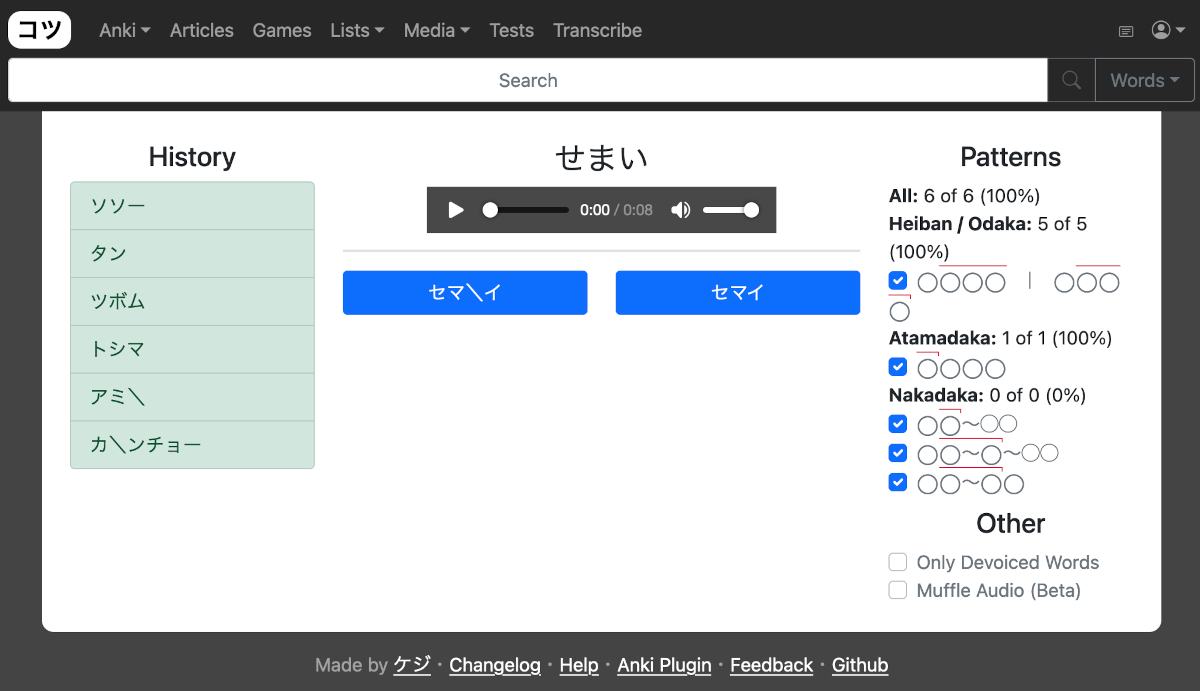
Kotu.io is a website with a variety of tools to help students learn Japanese. Among these is a tool for interfacing with Anki, another that helps generate subtitles in transcribed media, and even a reader app that lets you paste in a link to some Japanese text – for example, an article – which enables コツ to highlight words based on frequency, pitch accent, or show the point in a word where the pitch drops.
Pitch accent is a common sticking point for many English-speaking Japanese learners, as Japanese is a pitch accent language as opposed to English's stress-accent focus.
コツ also hosts a few different tests, the most interesting one being for Pitch Accent Minimal Pairs. Pitch accent is a common sticking point for many English-speaking Japanese learners, as Japanese is a pitch accent language as opposed to English's stress-accent focus. For Japanese learners looking to improve their pronunciation this is a great resource. The ability to discern the different pitch accent patterns as they are applied to words, and then turning this newfound mindfulness on one's own Japanese isn't something they typically teach in a Japanese-language classroom, but it's invaluable to sounding more natural in spoken Japanese.
To that end, コツ's Pitch Accent Minimal Pairs Perception Test is one of the best ways to check your ability to perceive different pitch accent patterns. A minimal pair is a set of two words whose only difference is a single sound. The site plays audio of a native recording of a word in isolation, and then asks you to select which pronunciation was given. You can filter by which patterns you'd like to be tested on, either Heiban, Odaka, Atamadaka, Nakadaka, or a combination from that list. You're graded as you go, and given the opportunity to hear both pronunciations after a mistake, to help avoid it in the future. It's a simple test, but it doesn't leave much to be desired. For Japanese learners looking to improve their pronunciation, it's well worth your time to begin incorporating this pitch accent test and other forms of pitch accent awareness as soon as possible to your study habits.
茅ケ崎みなみ
Chigasaki Minami is a Japanese YouTuber, whose vlogs focus on traveling Japan via motorcycle, camping, and other outdoor activities. Chigasaki leans into her similarities with Shima Rin from the anime series ゆるキャン△, invoking the character at different times through her appearance and actions, so fans of the anime or manga or similar series should definitely check it out.
Beyond being an entertaining YouTube channel, Chigasaki's videos are also great listening practice. She speaks relatively slowly and clearly, and like many Japanese videos, there are subtitles covering almost every line. While a lot of the vocabulary is hobby related, from camping gear or motorcycle parts, there's also a lot of daily life and Chigasaki's commentary to even things out.
Given the specific focus, Chigasaki's videos might not be for everyone, but for anyone looking for a relaxing way to immerse themselves in Japanese, look no further.
Onomato Project

While studying Japanese, you may have come across some unusual words that seem to describe a feeling or sound in a way that's difficult to translate into English. Words like ガチャガチャ — the sound of a clatter, or ぽかぽか, which describes a pleasantly warm feeling. These words, both 擬音語 (a word that mimics a sound) and 擬態語 (a word that describes a condition or sensation) are broadly grouped under the umbrella of オノマトペ, or onomatopoeia words.
While onomatopoeia is not nearly as important in English, their wide and culturally specific use in Japanese make them an integral part of the language. They can also be quite tricky for Japanese learners to fully wrap their heads around with different categories of sound that depend on an object’s weight, size, and composition among lots of other factors. Thankfully, Onomato Project is here to help!
Onomato Project is an online compendium of many of the most common onomatopoeia words and their definitions. The main page has a list of words that each link to their own page containing English definitions, example sentences, and some advice on usage. Many of the entries also have cute illustrations that help to get the point across. While the site isn't quite comprehensive, as it's missing a few of the high-use オノマトペ such as ごちゃごちゃ, the list it offers is quite large and encompasses a wide range of sounds and senses.
Ulangi App
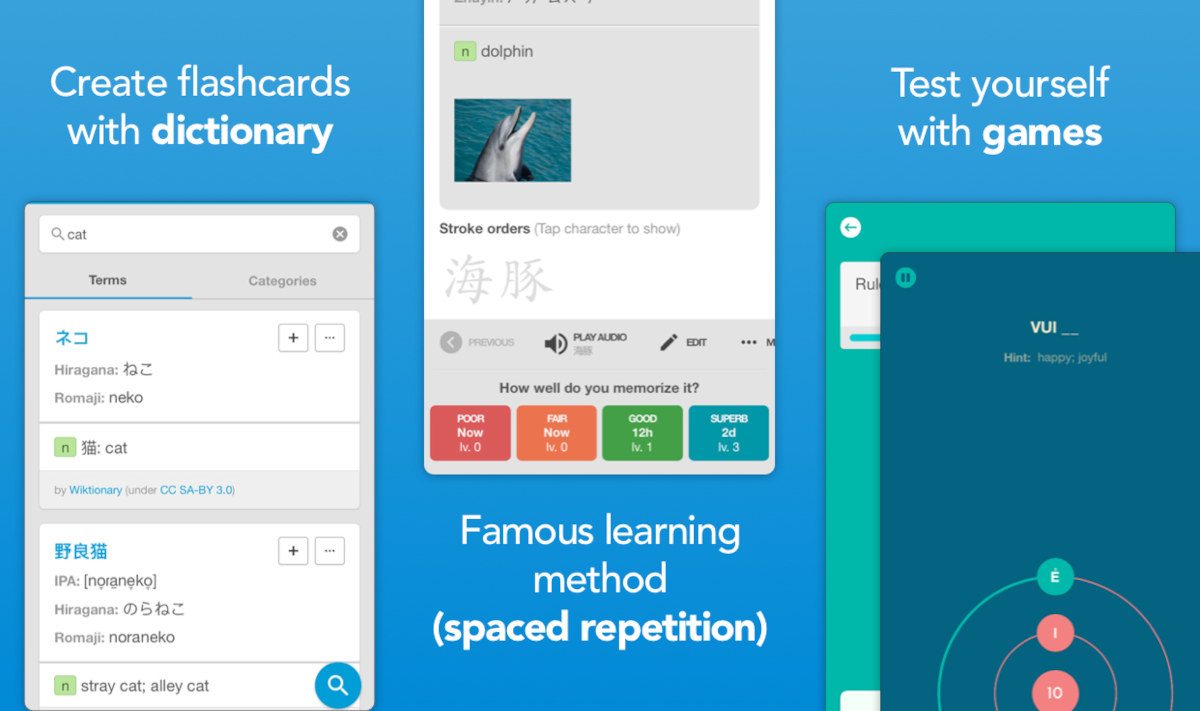
Ulangi is a new flashcard language learning app that uses spaced repetition and a variety of different modes to make creating and studying from flashcards easier. After downloading the app, you're asked a few questions to get set up, including what language you're learning. From there, you're dropped into the main interface, which consists of five pages.
The first page is "Manage," which lets you make changes to the cards you've made. On the next page, "Discover," you can search for words or entire categories of words, which is how Ulangi groups cards. For example, searching for and adding a card for 梅雨 created a new category called "meteorology" on my Manage page. This makes it easy to study a specific topic, such as "fruits" or "home appliances." The "Learn" page contains all the study options, followed by a "Progress" page that has your stats, and a "More" page with adjustable settings. On the Learn page, you're able to study with your cards in a number of ways. First is "Spaced Repetition," where you're shown a card and have to judge yourself on your ability to recall the information; for example, the meaning and reading of a vocabulary word. You then grade yourself, hitting a button depending on how well you do, which changes the interval until you need to review the term again from only a couple of minutes to a month or more. These buttons should be familiar to anyone who has used another flashcard program such as Anki. Beyond "Spaced Repetition" there's a "Writing" section where you type in an answer similar to WaniKani, a "Quiz" to test yourself, and two different games, called "Reflex" and "Atom." Reflex is a speed-based quiz game, and Atom has you spelling out your review items.
While Ulangi is lacking some of the in-depth features and integrations in comparison to Anki, the simplicity of the system also makes the barrier to entry much lower. For Japanese learners that want to use flashcards to memorize things but don't want to spend time configuring and managing their own cards and decks, Ulangi is a great way to get off the ground right away.
ドライブ・マイ・カー / Drive My Car
The film Drive My Car has had huge success since its release in November 2021. It's based on the short story collection titled 女のいない男たち (Men Without Women) by acclaimed author, Murakami Haruki. Over the three-hour long period several different storylines play out around the main character, Kafuku Yūsuke, and those around him. Many scenes take place inside of his red Saab 900 car, which becomes an iconic focal point from the very beginning. Without giving too much away, the main themes of the movie are passion, creative growth, retribution for wrongdoings, and self-forgiveness.
Watching this film, it's easy to see how it became such a big hit. The overall cinematography is stunning, with beautiful scenes of Japanese roadways and natural backdrops. The acting is incredible throughout and leaves you feeling for each character in different ways. At times, this film can be slow-moving and challenging to follow, but if you can push past that, the winding roads of the plot will take you on an emotional journey.
A large portion of the film focuses on the production of a play the group is putting on, oftentimes the language used can be poetic and lyrical.
Unless you're familiar with the plot already, you may want to consider watching this film with Japanese or English subtitles. Because a large portion of the film focuses on the production of a play the group is putting on, oftentimes the language used can be poetic and lyrical. The scenes involving the play also involve other languages, like Korean, Mandarin, German, and Tagalog. Subtitles are automatically included for these languages, so you may be doing a fair share of reading along anyway. With English subtitles, this film can be enjoyed by anyone, no matter their level of Japanese knowledge. If you're at an intermediate level and want to test out your listening abilities, I'd recommend trying without subtitles at first and seeing how you feel. As of March 2022, the movie is still playing at theaters inside and outside Japan while it is also available on several streaming services. US residents with a subscription to HBO Max can enjoy this film for free!
Nihongo Alive: Listen & Learn from Real-life Conversations Beginning & Intermediate
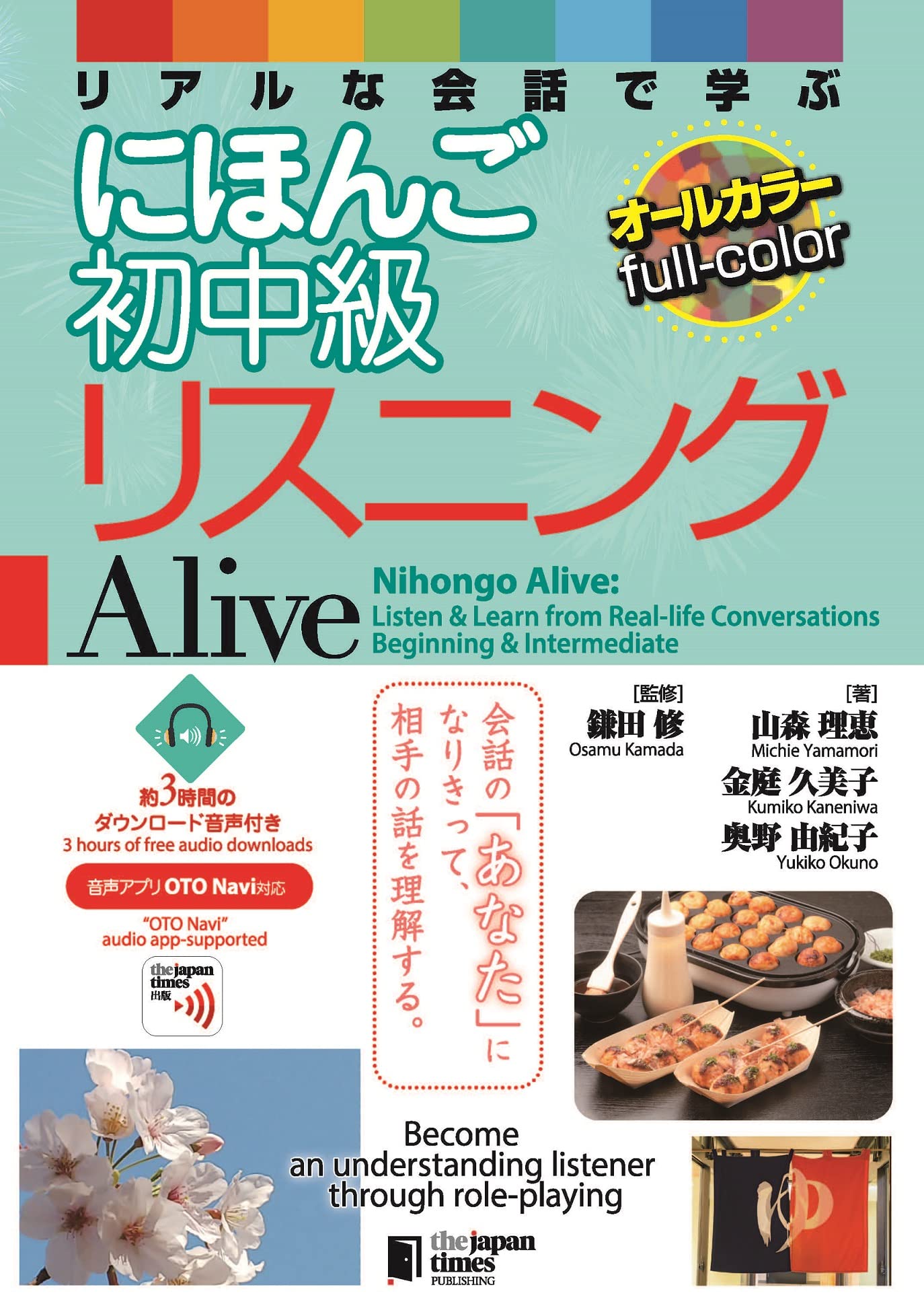
Nihongo Alive is a textbook accompanied by audio and an answer key that is geared towards practicing authentic conversations. The audio recordings can be accessed through the Oto Navi app, which you will have to download onto your device to listen to. The textbook is broken into eight unique sections, each featuring both listening and speaking exercises. Specifically, you'll find conversations where you are speaking to a pre-recorded partner and responding to them, filling in missing parts to sentences while you listen, and answering questions about the script. The topics are varied and cover food, games, travel, and other subjects common to beginner language-learners.
After giving this textbook a try, I do think the dialogue is truer to real-life conversations than a typical textbook, such as Genki or Minna no Nihongo. At times though, the conversations can come across as a bit casual and awkward. Also, there isn't as much opportunity for output as there is input, as the speaking practice tends to be quite short.
This textbook is suggested for beginner and intermediate Japanese language learners, which I think is accurate. However, I'd say it isn't geared toward true beginners, as there isn't much English and it could be difficult to understand some parts. Ideally, it seems great for a classroom setting, where you could hear pronunciation advice from a teacher.
まほろばことば
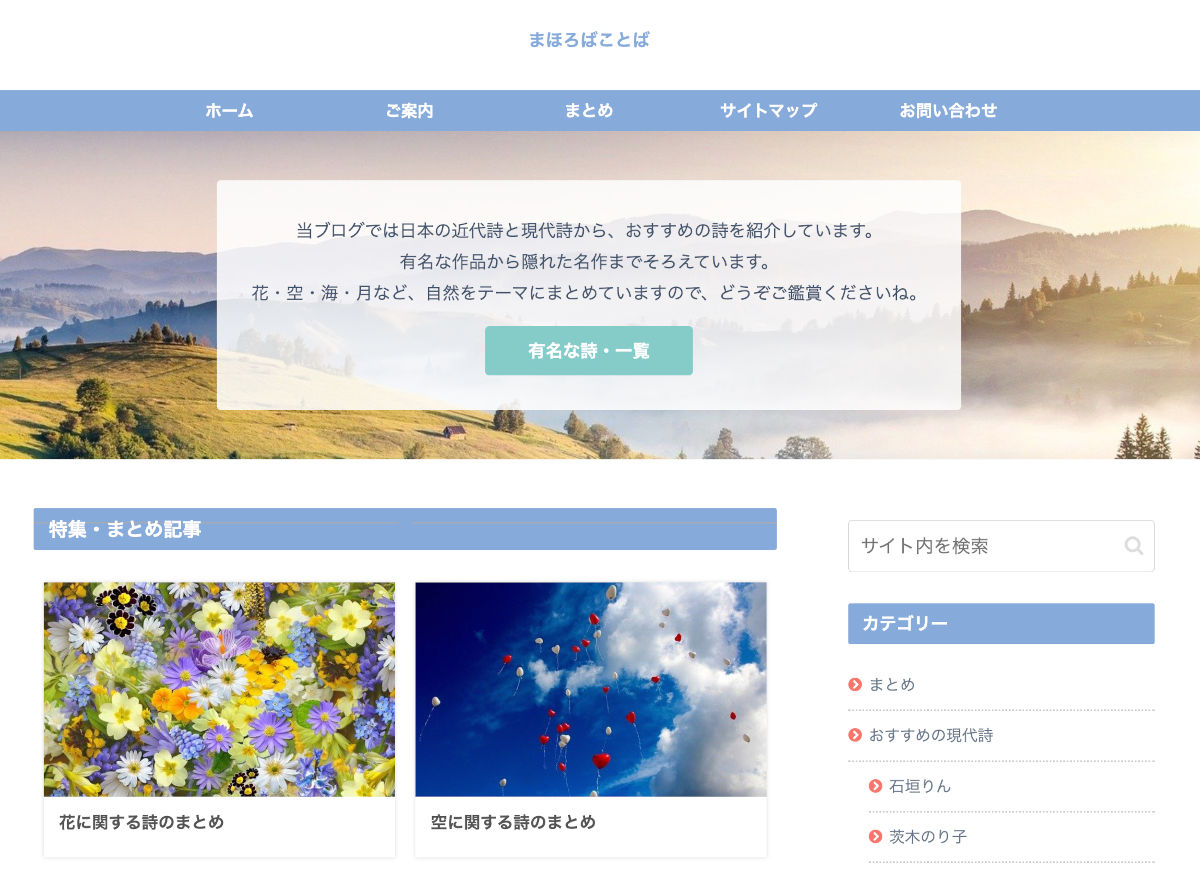
This blog's name comes from まほろば meaning "paradise" in old Japanese and ことば, meaning "word." Perhaps this also ties into the name of the blog creator, Mahoshi. On the blog, Mahoshi shares that the reason they created this site was to provide a blissful space online to share modern Japanese poetry. The types of poetry the site offers are 現代詩 (gendaishi) and 近代時 (kindaishi), which are from around the Meiji era to the mid-Showa era. All of the poems on the site are the author's personal recommendations.
The poems are paired into categories, such as poems related to the sky, the ocean, the moon, and so on. After clicking on a poem, you can read an introduction, the poem itself, and more detailed information about it. The poems are relatively short and the blogger breaks down the writing in their own words. The site is likely best suited for an intermediate to advanced learner as the content can use upper-level wording.
日本語の森 JLPT この一冊で合格する
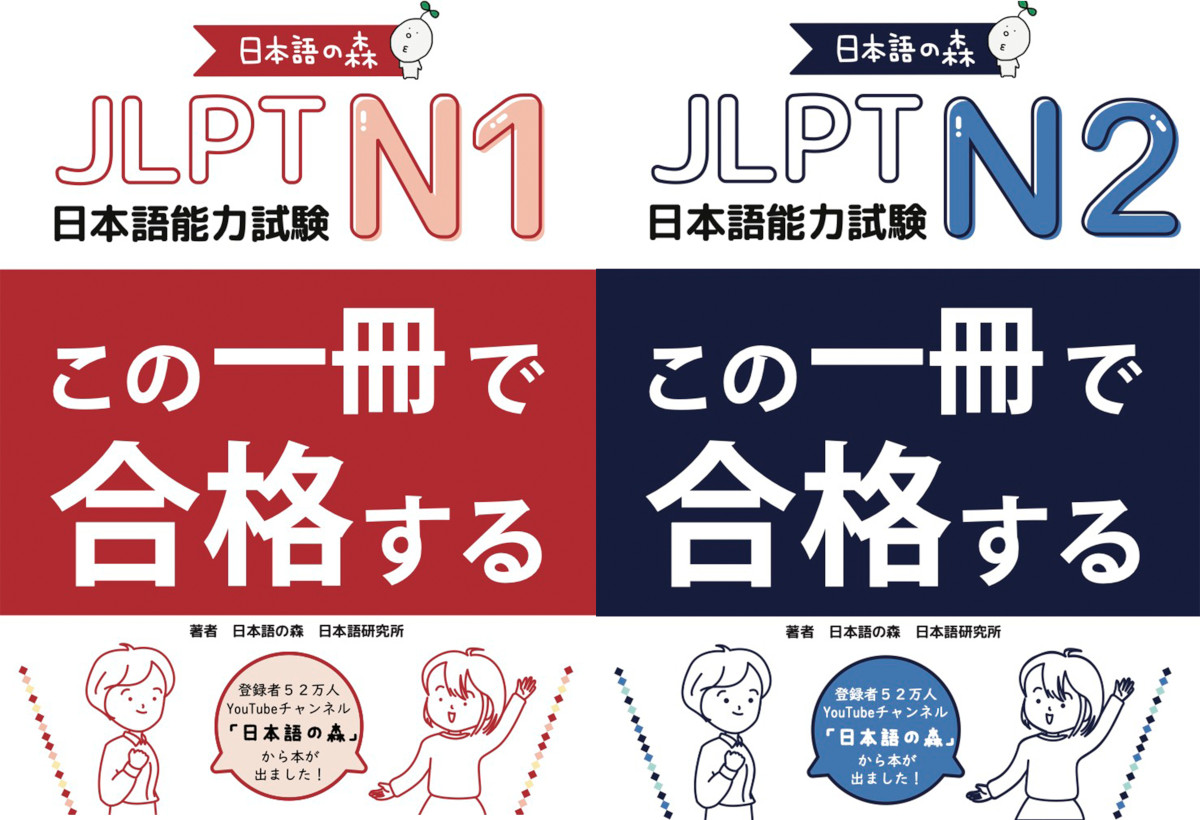
この一冊で合格する is a book series for JLPT preparation created by 日本語の森 Nihongo no Mori, which started out as a YouTube channel in 2013. As of March 2022, they currently have editions for the N2 and N1 levels — N2この一冊で合格する, and N1この一冊で合格する.
This series is designed to be a one-stop-shop for studying for and passing the JLPT. Both the N1 and N2 versions are structured exactly the same and contain a trove of useful content related to each level of the test. These books begin with a brief explanation (in Japanese) of the JLPT at each level, followed by a content breakdown, a chapter dedicated to vocabulary and kanji, a chapter about grammar, another about reading, and finally a chapter about listening. At the end of each book are two mock exams, answer sheets, listening exercise scripts, and a marksheet.

Each book consists of four chapters: vocabulary, grammar, reading and listening.
The vocabulary and kanji chapter is simply a long checklist of words generally grouped by structure – single kanji words, two-letter kanji words, words with a mix of kanji and hiragana, katakana words, and more. No definitions are provided; it seems like readers need to look up any words they are unfamiliar with.
The grammar chapter presents similar grammar points together with an explanation in Japanese, how to form each grammar pattern, and a few example sentences. After five to ten related grammar points are given, you will find exercises afterward that utilize each one in formats seen on the actual JLPT. The N1 book has 130 grammar points while the N2 has 135. As far as I can see, there are no overlapping or repeating grammar points between each version.
The reading chapter begins with tips and tricks for solving questions involving reading problems. Things like connecting phrases, conjunctions, and explanatory words are spotlighted. There are plenty of examples given, followed by practice problems organized by passage length and type.
The final chapter deals with the listening section of the JLPT. Examples, explanations, and practice listening questions are organized based on five different types of questions that usually appear on the exam. The audio quality is decent and the 日本語の森 voice actors do a good job of recreating what you would hear on the actual JLPT listening sections.
These books seem like great resources for anyone thinking of taking upper-level JLPT exams. After creating a paid account, you are able to access PDF versions of these books. Physical copies are also available to order through the LINE app for those who live in Japan. In case you are just looking for a list of vocabulary and expressions you can use to prepare for the JLPT exam, there are also editions that only include the vocabulary portion of these books: N1 4000 Essential Words and N2 3500 Essential Words — English and Chinese versions respectively. These vocabulary-focused editions have translations alongside the vocabulary as well.
We've reached the end of this journey! We hope you enjoyed learning about these new resources we've tested and loved. If you find any other new Japanese learning resources that you love, send us an email at hello@tofugu.com or reach out to us on Twitter @tofugu. Even if it's only new to you, send it our way. We're always on the lookout for quality resources. See you next time!
